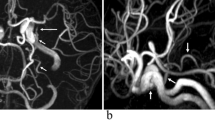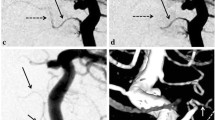Abstract
Purpose
The purpose of the study is to describe a case of ophthalmic artery (OA) arising from the presumed meningohypophyseal trunk (MHT) of the cavernous internal carotid artery (ICA).
Case report
A 63-year-old woman suspected of having cerebral infarctions underwent cranial magnetic resonance (MR) imaging and MR angiography. MR angiography showed a right OA that was found to arise from the superolateral aspect of the proximal cavernous ICA. This OA entered the orbit via the superior orbital fissure (SOF).
Discussion
Rarely, an OA arises from the inferior aspect of the middle cavernous ICA at the level of the inferolateral trunk (ILT) and enters the orbit via the SOF. This OA variation was traditionally regarded as a persistent primitive dorsal OA but is now believed to be due to the persistence of the lateral branch of the primitive maxillary artery. The present case had an OA arising from the superolateral aspect of the more proximal cavernous ICA than the origin of the ILT, which was suggested to be the origin of the MHT. Persistence of the proximal segment of the trigeminal artery may play an important role in the formation of this extremely rare variation.
Conclusion
To identify this extremely rare OA variation, careful observation of source images and the creation of volume-rendering MR angiography images are important.



Source images of MR angiography (a–d) show that the origin of the right OA is the superolateral aspect of the proximal cavernous ICA (long arrows), at the level of the presumed meningohypophyseal trunk. This artery enters the orbit via the superior orbital fissure (short arrow)

Similar content being viewed by others
Availability of data and materials
Not applicable.
References
Bertelli E, Regoli M, Bracco S (2017) An update on the variations of the orbital blood supply and hemodynamic. Surg Radiol Anat 39:485–496. https://doi.org/10.1007/s00276-016-1776-9
Bonasia S, Bojanowski M, Robert T (2020) Embryology and anatomical variations of the ophthalmic artery. Neuroradiology 62:139–152. https://doi.org/10.1007/s00234-019-02336-4
N’da HA, Peltier J, Zunon-Kipré Y, Alsaiari S, Foulon P, Legars D, Havet E, (2014) An unusual superolateral origin of ophthalmic artery: an anatomic case report. Surg Radiol Anat 36:95–97. https://doi.org/10.1007/s00276-013-1132-2
Ohshiro S, Inoue T, Hamada Y, Matsuno H (1993) Branches of the persistent primitive trigeminal artery–an autopsy case. Neurosurgery 32:144–148. https://doi.org/10.1227/00006123-199301000-00025
Parlato C, di Nuzzo G, Luongo M, Tortora F, Briganti F (2011) Anatomical variant of origin of ophthalmic artery: case report. Surg Radiol Anat 33:275–278. https://doi.org/10.1007/s00276-010-0745-y
Rivera R, Choi IS, Sordo JG, Giacaman P, Badilla L, Bravo E, Echeverria D (2015) Unusual origin of the left ophthalmic artery from the basilar trunk. Surg Radiol Anat 37:399–401. https://doi.org/10.1007/s00276-014-1327-1
Uchino A (2021) Intracavernous internal carotid artery-originating ophthalmic artery entering the orbit via the optic canal. Surg Radiol Anat 43:1967–1968. https://doi.org/10.1007/s00276-021-02835-1
Uchino A, Saito N, Ikeda S, Ishihara S (2015) Ophthalmic artery arising from the anterior cerebral artery diagnosed by MR angiography. Surg Radiol Anat 37:1009–1012. https://doi.org/10.1007/s00276-015-1441-8
Uchino A, Saito N, Kurita H, Ishihara S (2013) Double ophthalmic arteries arising from the internal carotid artery. Surg Radiol Anat 35:173–175. https://doi.org/10.1007/s00276-012-1005-0
Uchino A, Saito N, Takahashi M, Kozawa E, Mizukoshi W, Nakajima R, Okano N (2013) Persistent dorsal ophthalmic artery and ophthalmic artery arising from the middle meningeal artery diagnosed by MR angiography at 3 T. Surg Radiol Anat 35:775–782. https://doi.org/10.1007/s00276-013-1085-5
Willinsky R, Lasjaunias P, Berenstein A (1987) Intracavernous branches of the internal carotid artery (ICA). comprehensive review of their variations. Surg Radiol Anat 9:201–215. https://doi.org/10.1007/BF02109631
Acknowledgements
Not applicable.
Funding
The authors did not receive support from any organization for the submitted work.
Author information
Authors and Affiliations
Contributions
AU carried out the study design and drafted the manuscript. AU and SI reviewed the manuscript critically, and have read and approved the final manuscript.
Corresponding author
Ethics declarations
Conflict of interest
Not applicable.
Ethical approval and consent to participate
All procedures performed in studies involving human participants were in accordance with the ethical standards of the institutional and/or national research committee and with the 1964 Helsinki Declaration and its later amendments or comparable ethical standards.
Consent for publication
The patient signed informed consent regarding publishing his data and photographs.
Additional information
Publisher's Note
Springer Nature remains neutral with regard to jurisdictional claims in published maps and institutional affiliations.
Rights and permissions
About this article
Cite this article
Uchino, A., Ishihara, S. Ophthalmic artery arising from the presumed meningohypophyseal trunk of the cavernous internal carotid artery diagnosed by magnetic resonance angiography. Surg Radiol Anat 44, 1025–1028 (2022). https://doi.org/10.1007/s00276-022-02975-y
Received:
Accepted:
Published:
Issue Date:
DOI: https://doi.org/10.1007/s00276-022-02975-y




